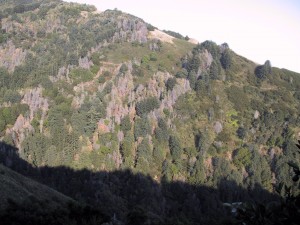For some species, climate change is increasing vulnerability to insect damage; for others, climate change is increasing their resistance to insect damage.
Areas currently seriously affected by disease and insect damage may be able to bounce back with warmer conditions if these conditions are too warm for the insects or disease. That means that areas too cold for these insects or diseases may become susceptible to infection and infestation. The temperature change will either continue to prohibit or exacerbate insect damage and disease.

Insects and pathogens respond rapidly to climate change because of their sensitivity to temperature, short generation times, and high mobility. The southern pine beetle, for example, is moving farther north as the temperatures warm and the conditions become favorable for their survival. Trees are sensitive to climate change. It affects trees defenses, tolerances, and if affects and alters pre-existing community interactions.
Warmer temperatures and increased CO2 and may boost tree growth, which may pull out higher amounts of carbon in the short run. This increase in productivity will lead to a potential increase in timber productions. This increased tree productivity is not infinite, however, due to other limiting factors and nutrients.
http://www.washingtonpost.com/national/health-science/climate-change-affecting-north-american-forests-researchers-find/2013/10/14/2e9d17d4-3515-11e3-be86-6aeaa439845b_story.html
http://www.esajournals.org/doi/abs/10.1890/13-0160.1
http://upload.wikimedia.org/wikipedia/commons/f/f8/Sudden_oak_death_IMG_0223.JPG
Insect and Disease Response to Climate Change
Leave a Comment
Posted on April 28, 2014 by bejohnson
For some species, climate change is increasing vulnerability to insect damage; for others, climate change is increasing their resistance to insect damage.
Areas currently seriously affected by disease and insect damage may be able to bounce back with warmer conditions if these conditions are too warm for the insects or disease. That means that areas too cold for these insects or diseases may become susceptible to infection and infestation. The temperature change will either continue to prohibit or exacerbate insect damage and disease.
Insects and pathogens respond rapidly to climate change because of their sensitivity to temperature, short generation times, and high mobility. The southern pine beetle, for example, is moving farther north as the temperatures warm and the conditions become favorable for their survival. Trees are sensitive to climate change. It affects trees defenses, tolerances, and if affects and alters pre-existing community interactions.
Warmer temperatures and increased CO2 and may boost tree growth, which may pull out higher amounts of carbon in the short run. This increase in productivity will lead to a potential increase in timber productions. This increased tree productivity is not infinite, however, due to other limiting factors and nutrients.
http://www.washingtonpost.com/national/health-science/climate-change-affecting-north-american-forests-researchers-find/2013/10/14/2e9d17d4-3515-11e3-be86-6aeaa439845b_story.html
http://www.esajournals.org/doi/abs/10.1890/13-0160.1
http://upload.wikimedia.org/wikipedia/commons/f/f8/Sudden_oak_death_IMG_0223.JPG
Category: Eastern Issues, Featured, Pacific Northwest Issues, Rocky Mountain Issues
Recent Posts
Recent Comments
Archives
Categories
Meta